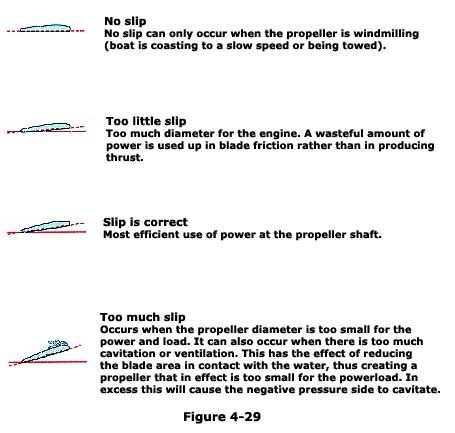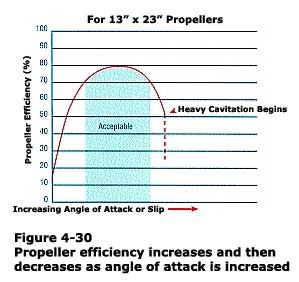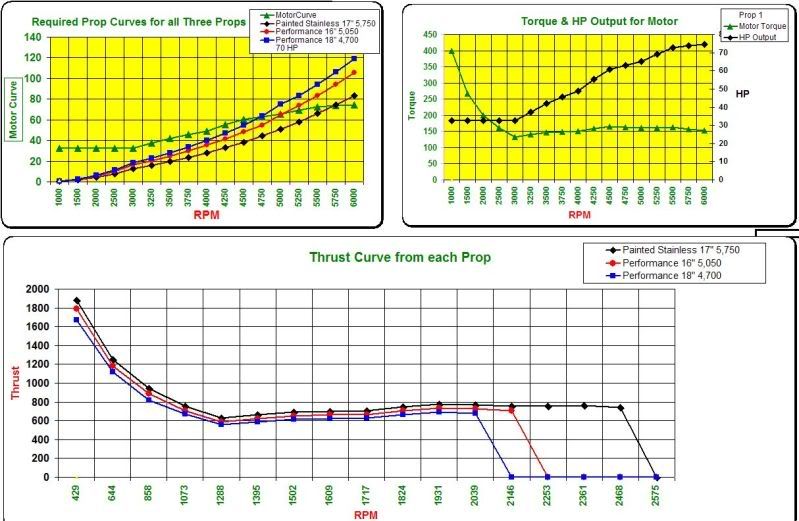Prop selection
One of the most asked questions is What Prop?
The next is how to get the best fuel mileage.
You will need to do several things to get this done.
First make sure your hull is clean. Next make sure your engine is properly tuned.
Now you need to know the manufactures maximum engine RPM and the Gear ratio of your lower unit.
You will need a GPS, and a properly working tachometer.
Take your boat out with normal load (What is in your Boat most of the time) and check maximum speed with GPS, look at your tach and see what RPM'S you are running. If your tach shows you are running 5000 and the manufacture says you should be running 5500 then go down in pitch, figure 200 RPM's for each drop. Example if you were running a 24 pitch prop at 5000 then you could go to 22 pitch prop and get your RPM's to 5400.
A 22 Pitch prop would theoretically move your boat 22 inches in one revolution. But you have slippage (efficiency), and this is one number you need to watch. Here is the formula you can use.
RPM divided by the gear case ratio times Pitch of Prop divided by 12 times 60 divided by 5280 = MPH.
Example on a 150 Johnson Running 5500 RPM's with a 1.86:1 Gear case and 24 pitch Prop:
5500 ? 1.86=2956.99 X 24=70967.76 ? 12=5913.98 X 60= 354838.8 ? 5280 = 67.20 MPH
RPM ? Gear Ratio x Prop Pitch ? 12 x 60 ? 5280 = MPH
Then take GPS speed ? Formula MPH = Efficiency
The speed you found on your GPS and divide that by the speed you came up with in the calculation and this is your efficiency. Example 61(GPS SPEED) ? 67.20(formula speed) and you will find you have 90 % efficiency . This is a good number. The higher the efficiency number the better, you cannot have above 100%.This is where different design and materials in props come into play. Different design props raise your efficiency rate and bring you closer to theory speed. Example stainless compared to aluminum. If you read some posts you will see some of the numbers are not right. Example a boat turning 5500 RPM's with a 1.86 to one gear case and a 22 pitch Prop cannot run 70 MPH!
So according to this theory the bigger the prop the faster the boat, this is true except your engine will run out of power and not be able to turn max RPM's! So you have to find the largest pitch that will allow your engine to Run The RECOMMENDED MAX RPM's.
That is why you need to check what you have first!
OK now for fuel efficiency:
Check your boat at Different RPM'S and speeds. Write these down. Next take the formula above and find the highest efficiency number at a speed and this will be your best fuel mileage speed.
Example 3500 RPMS at 40MPH(GPS) divided by 42.7 (formula) equals 93% efficiency and at 3000 RPM's at 35 MPH (GPS) divided by 36.66 (formula) equals 95% efficiency. 35 Mph would be your best efficiency speed. Your engine fuel consumption verses speed would be the best. Try this at several speeds to get the best efficiency number, don't worry you can't get 100%! Anything above 90% is good and 95% is excellent!
Now don't run out and buy a prop using this! There are different design props......cups, diameter, pitch, material. Use this as a reference and call iBoats and let them help you!~ they sell a lot of props and you can't beat experience!!!
Gary Cooper
One of the most asked questions is What Prop?
The next is how to get the best fuel mileage.
You will need to do several things to get this done.
First make sure your hull is clean. Next make sure your engine is properly tuned.
Now you need to know the manufactures maximum engine RPM and the Gear ratio of your lower unit.
You will need a GPS, and a properly working tachometer.
Take your boat out with normal load (What is in your Boat most of the time) and check maximum speed with GPS, look at your tach and see what RPM'S you are running. If your tach shows you are running 5000 and the manufacture says you should be running 5500 then go down in pitch, figure 200 RPM's for each drop. Example if you were running a 24 pitch prop at 5000 then you could go to 22 pitch prop and get your RPM's to 5400.
A 22 Pitch prop would theoretically move your boat 22 inches in one revolution. But you have slippage (efficiency), and this is one number you need to watch. Here is the formula you can use.
RPM divided by the gear case ratio times Pitch of Prop divided by 12 times 60 divided by 5280 = MPH.
Example on a 150 Johnson Running 5500 RPM's with a 1.86:1 Gear case and 24 pitch Prop:
5500 ? 1.86=2956.99 X 24=70967.76 ? 12=5913.98 X 60= 354838.8 ? 5280 = 67.20 MPH
RPM ? Gear Ratio x Prop Pitch ? 12 x 60 ? 5280 = MPH
Then take GPS speed ? Formula MPH = Efficiency
The speed you found on your GPS and divide that by the speed you came up with in the calculation and this is your efficiency. Example 61(GPS SPEED) ? 67.20(formula speed) and you will find you have 90 % efficiency . This is a good number. The higher the efficiency number the better, you cannot have above 100%.This is where different design and materials in props come into play. Different design props raise your efficiency rate and bring you closer to theory speed. Example stainless compared to aluminum. If you read some posts you will see some of the numbers are not right. Example a boat turning 5500 RPM's with a 1.86 to one gear case and a 22 pitch Prop cannot run 70 MPH!
So according to this theory the bigger the prop the faster the boat, this is true except your engine will run out of power and not be able to turn max RPM's! So you have to find the largest pitch that will allow your engine to Run The RECOMMENDED MAX RPM's.
That is why you need to check what you have first!
OK now for fuel efficiency:
Check your boat at Different RPM'S and speeds. Write these down. Next take the formula above and find the highest efficiency number at a speed and this will be your best fuel mileage speed.
Example 3500 RPMS at 40MPH(GPS) divided by 42.7 (formula) equals 93% efficiency and at 3000 RPM's at 35 MPH (GPS) divided by 36.66 (formula) equals 95% efficiency. 35 Mph would be your best efficiency speed. Your engine fuel consumption verses speed would be the best. Try this at several speeds to get the best efficiency number, don't worry you can't get 100%! Anything above 90% is good and 95% is excellent!
Now don't run out and buy a prop using this! There are different design props......cups, diameter, pitch, material. Use this as a reference and call iBoats and let them help you!~ they sell a lot of props and you can't beat experience!!!
Gary Cooper
Last edited:























